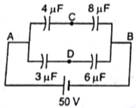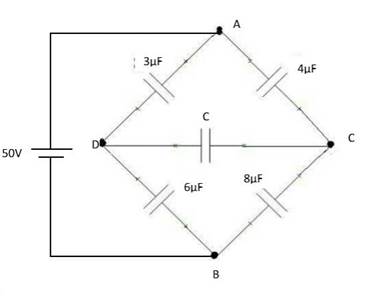Take the potential of the point B in figure to be zero.
a) Find the potentials at the points C and D.
b) If a capacitor is connected between C and D, what charge will appear on this capacitor?

From the fig. the capacitors 4μF and 8μF are in series.
![]()
Capacitors 3μF and 6μF are in series
![]()
C1 and C2 are in parallel combination
Two rows are in parallel. So the voltage across each row is the same, and that is equal to 50V.
The charge on the branch ACB is
Charge on the branch ADB is
QADB ![]()
Voltage,![]()
Where
Q is the charge on the capacitor
C is the capacitance of the capacitor
The voltage at 4μF is =![]()
The voltage at 8μF is =![]()
Voltage at node C is =![]() V
V
The voltage at 3μF is![]()
The voltage at 6μF is![]()
The voltage at node![]()

b) if a capacitor is connected between node C and D. if we redraw the circuit, it will look like. Here bridge is balanced at the condition
![]()
![]()
![]()
the charge on the capacitor will be zero.
Because the bridge is balanced so the potential difference between C and D will be zero. So no charge flow will occur.
The voltage at node C and node D is same and is equal to ![]()
If a capacitor is connected between node C and D, the charge flow will be zero.